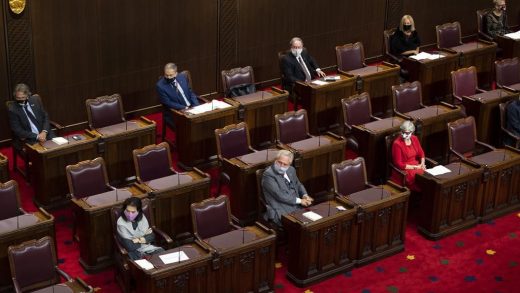
ROBERT KITCHIN/Stuff
Up to 80% of Wellington’s streets could drop to 30kph speed limits from 2024.
The majority of speed limits across Wellington look set to drop to 30kph from 2024 as part of a new speed-management plan.
On Thursday next week, councillors are expected to agree an approach to speed management should propose 30kph speed limits on all “non-arterial streets” and some streets within city and town centres, 40kph on all other arterial streets, and 50kph on some major arterial routes and high-volume roads.
The new speed limits would go out for public consultation in 2023, and could be introduced from 2024.
Councillor Iona Pannett, chairperson of the Wellington City Council’s planning and environment committee, said 80% of the road network could drop to 30kph.
READ MORE:
* Speed review: ‘Tomorrow’s too late for any loss of life’
* Council votes to keep Napier CBD speed limit at 50kmh – against staff, police and NZTA recommendations
* Speeds need to be more consistent around schools say rural principals
“We are responding extremely quickly to a new Government rule which allows us to put in place a speed- management plan,” Pannett said. The new rule took effect on May 19.
“I’m absolutely delighted with the staff, they’ve done a fantastic job. This is a real legacy piece of work.”
It will be mandatory from 2024 to have lower speed limits around schools. Councils must make a reasonable effort to have lower speed limits around at least 40% of schools by that date.
Pannett said that means lower speeds outside at least 33 of the 81 schools in the Wellington City Council catchment.
Kevin Stent
Speed limits will drop outside all schools, making it safer for children to walk or cycle to school.
“The issue is how much of the area around those schools need to be made safe? You could do just a couple of metres,” Pannett said.
“What we’re doing is saying that we’re going to take a catchment approach so that a child walking or cycling to school is safe.
“But we’re also doing it because it ties into our climate goals. It will make it safer, it will encourage people to mode shift, reduce noise and air pollution, and just generally make our schools more liveable.”
The Council has decided to lower speeds at least one kilometre from primary or intermediate schools, and 2.25km from secondary schools.
Decisions on which roads will remain at 50kph will only be made after consultation with the public, with speed limit reductions possible on all roads in the city.
The proposal councillors are set to opt for is option six of nine put forward to Council, and would see crash reduction benefits of $529 million over 40 years.
It would cost $44.8m to implement, and would have relatively high vehicle travel time increases, according to a Council report.
However, the cost benefit ratio was 7.7, meaning for every dollar spent, $7.70 would be earned back.
DAVID UNWIN/Stuff
Lucinda Rees says the proposal is “astonishing”, and other councils should follow suit.
The cost benefit analysis didn’t take into account benefits of a cleaner environment, or the liveability of the city, which Pannett said would be higher with option six than other proposals.
Lucinda Rees, from NZ School Speeds which advocates for safer speed limits outside schools, said Wellington’s plan was “astonishing”.
“I’m highly impressed. If that’s what they’re actually going to do, it’s immensely impressive,” Rees said.
“You have a significant percentage higher chance of survival if the speed limit if 30kph. It’s about 90%, and for every kilometre more the survival rate drops dramatically.”
Rees praised the distance Wellington’s council was planning to have lower limits outside schools, but said the 2.25km distance outside secondary schools might as well be extended to all schools.
“You don’t want to underestimate how far a young child might travel to school,” she said. “But either way, it’s colossal, this proposal.”


